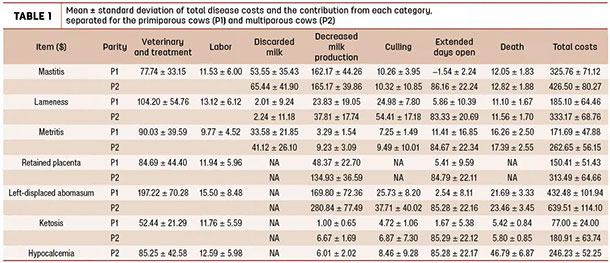In the last 10 years, we have seen a significant push from breeders everywhere to breed more naturally healthy, disease-resistant cows.
However, how much weight should be placed on these health traits and which ones should a dairy select for in order to maximize profitability? Because no two dairies are the same, the answer to this question isn’t simple. Current disease rates, treatment protocols, genetics and transition cow management will all play a role in how (and which) health traits should be considered in a breeding program.
Heritabilities and accuracy of health trait selection
Health traits are difficult to measure and are often inconsistently recorded from farm to farm. This reduces the heritability and makes estimating genetic values for individual diseases difficult. Heritabilities of health traits as estimated by the Council on Dairy Cattle Breeding range from 0.6% up to 3.1%. This means that only 3.1% of the variation seen in disease incidence on farm can be explained by genetic differences among animals. This does not mean progress can’t be made by selecting for these traits, but several-fold more data records are required to achieve the required accuracy.
Due to a large dataset and the power of genomics, theoretical reliabilities of individual health traits can range from 44%-56%. These reliabilities are calculated as part of the genomic evaluation process and measure how predictive the genomic values should be of future performance. This indicates producers should be confident these individual disease traits can be used to lower the incidence of specific problem diseases in their herds.
Genetic standard deviations of these health traits generally range from 0.1 to 1.3. This means that by selecting bulls which are one standard deviation above the mean (in the top 16% of the breed), producers can expect to lower disease incidence in the next generation by between 0.1% and 1.3% depending on the disease.
Another approach to selecting healthier animals is by measuring the overall strength of the immune system. This can be done in more than one way. Selecting for Productive Life will have an indirect effect on the overall strength of the immune system, as animals which stay in the herd longer are more likely to have had better resistance and resilience to disease throughout their lives. By considering the lifetime resistance to disease, and likelihood to stay in the herd versus individual disease incidence, we can better estimate the genetic components of this trait. Therefore, we observe a heritability of 8.5% in Productive Life compared to the lower heritabilities of individual health traits. This will also translate to a higher overall reliability of selection given a similar number of records.
A third approach to selecting for better health involves measuring the strength of an animal’s immune system directly. Directly testing the biological ability to recognize and respond to a pathogen eliminates the noise caused by management and environmental factors when measuring disease incidence. Therefore, we observe a much higher heritability of 30% with this more direct measure. Higher heritability also means high reliability of genomic selection, as the genetic variation of the trait is more easily identified and selected for.
Van Raden et al. published a study in 2009 examining the overestimation of reliabilities in genomic evaluations. What they found was traits which relied more on human recording (type traits, calving ease), were generally much more likely to be overestimated when compared to more accurately recorded biological measures such as fat and protein percentage.
Traits that are overestimated also tend to be those which are categorical measures rather than continuous variables, meaning traits are put into classes rather than on a full scale of values. Individual health traits may also fall into this category, as animals are either recorded with a disease or not, and there is no knowledge of the illness’ severity on a continuous scale. This increases confidence in the belief that using continuous biological data, where possible, can help increase the predictability of genomic breeding values and increase the chances genetics will translate to a difference on-farm and more stability of genomic proofs.
Economic values
At the end of the day, health traits are only a part of any breeding program, and understanding their true value will help to better estimate how they fit into your breeding goals. For any health trait there are two major questions to answer: How much reduction in disease can you expect, and what is the cost of each case of that disease on your farm?
As mentioned before, selecting on individual disease data can lead to decreases in disease anywhere between 0.1% and 1.3%. This is based on population averages, and it stands to reason, if you currently have higher genetic variation in disease incidence than the national average, you can expect greater gains from genetic selection. Likewise, if disease incidence rates are already low, selection may not be as beneficial in your herd. Selecting for biological traits have shown absolute decreases in disease incidence ranging from 0.1% to 3.2%.
Therefore, one must consider the value associated with eliminating each potential case of any given disease. Estimated costs of diseases vary from study to study, depending on what is to be included in the cost calculation. Liang et al. estimated the costs of each component of each disease, as shown here in Table 1.
Click here or on the image above to view it at full size in a new window.
For example, if selection against mastitis can lead to an expected reduction of the disease in a herd of 500 cattle by 1%, we can expect 5 less cases of mastitis. Assuming we include all associated costs, and cases are split between first-lactation and later-lactation cows, then a savings of $1,880 per year can be expected by selection across the herd for resistance to mastitis. However, we need to weigh this alongside selection for other traits (e.g. production, fertility) to maximize the entire genetic gain for your herd, using your farm-specific economics and goals.
The future of health traits
As we continue to learn more about measuring how cows fight off diseases, selection for resistance to disease is going to become increasingly more accurate. By using a combination of biological and on-farm traits, one can maximize the expected reductions in disease on farm. Using genetics as a key tool to increase the ability of cattle to be both resistant and resilient to disease will become increasingly important in your breeding goals, as we continue to work towards decreasing antibiotic use and improving sustainable practices on-farm. ![]()
Dr. Steven Larmer is the senior manager of the genomics programs at Semex.







